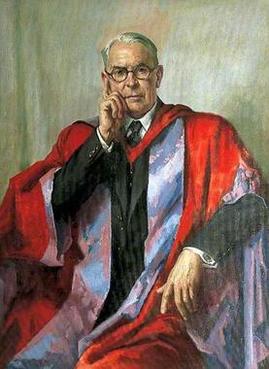Archibald Leman Cochrane was a Scottish physician noted for his book, Effectiveness and Efficiency: Random Reflections on Health Services, which advocated the use of randomized controlled trials (RCTs) to improve clinical trials and medical interventions. His advocacy of RCTs eventually led to the creation of the Cochrane Library database of systematic reviews, the UK Cochrane Centre in Oxford and Cochrane, an international organization of review groups that are based at research institutions worldwide. He is known as one of the fathers of modern clinical epidemiology and is considered to be the originator of the idea of evidence-based medicine. The Archie Cochrane Archive is held at the Archie Cochrane Library at University Hospital Llandough, Penarth.

Sir Cyril Astley Clarke was a British physician, geneticist and lepidopterist. He was honoured for his pioneering work on prevention of Rh disease of the newborn, and also for his work on the genetics of the Lepidoptera.

Morriston Hospital is a 750-bed hospital located in Cwmrhydyceirw near Morriston in Swansea, Wales. It is managed by Swansea Bay University Health Board. Alongside its role as a district general hospital, Morriston is a teaching hospital for medical students of Swansea University Medical School.

Barbara Mary Ansell was a British medical doctor and the founder of the field of paediatric rheumatology. Ansell was notable for outstanding contributions to the advancement of paediatric knowledge, specifically defining chronic joint disorders and the improvement of their management.

Swansea University Medical School is a medical school on Swansea University's Singleton campus. It is linked to additional teaching centres located throughout South and West Wales, including Cefn Coed Hospital, Singleton Hospital and Morriston Hospital in Swansea, Prince Philip Hospital in Llanelli, Withybush General Hospital in Haverfordwest and Bronglais Hospital in Aberystwyth. The Medical School also has a network of primary care teaching centers.

Dame Parveen June Kumar is a British doctor who is a Professor of Medicine and Education at Barts and The London School of Medicine and Dentistry. She worked in the NHS for over 40 years as a consultant gastroenterologist and physician at Barts and the London Hospitals and the Homerton University Hospital. She was the President of the British Medical Association in 2006, of the Royal Society of Medicine from 2010 to 2012, of the Medical Women's Federation from 2016 to 2018 and of the Royal Medical Benevolent Fund from 2013 to 2020. She was also Vice President of the Royal College of Physicians from 2003 to 2005. In addition, she was a founding non-executive director of the National Institute of Clinical Excellence, chaired the Medicines Commission UK until 2005, and also chaired the BUPA Foundation Charity for Research until 2013.

Walter Somerville CBE (1913–2005) was an Irish cardiologist who played a leading role in heart surgery at London's Middlesex and Harefield hospitals.
Hugh Morriston Davies was a Welsh thoracic surgeon, the first to perform a dissection lobectomy in the world, and the first to perform a thoracoplasty in the United Kingdom, both firsts achieved in 1912.

Joseph Griffiths Swayne (1819–1903) was an English obstetric physician. He is now known for investigations on cholera, which may have anticipated the discovery of the responsible micro-organism by Robert Koch
Katharine Georgina Lloyd-Williams CBE was a British anaesthetist, general practitioner and medical educator. She was a consultant anaesthetist at the Royal Free Hospital from 1934 and dean of the Royal Free Hospital School of Medicine from 1945, retiring from both posts in 1962.

Arthur Tudor Edwards was a Welsh thoracic surgeon, who worked at the Westminster Hospital, the Royal Brompton Hospital and Queen Mary's Hospital, Roehampton and pioneered lung surgery, in particularly pulmonary tuberculosis and lung tumours.

Sir Alan Aird Moncrieff, was a British paediatrician and professor emeritus at University of London. He was most notable for developing the first premature-baby unit in 1947. It was Moncrief who recognised and developed the concept of daily parental visits to the ward, which he developed while at Great Ormond Street, well before the need for this became recognised, and with his ward sister, published an article on Hospital Visiting for Children in 1949.
Sir Douglas Vernon Hubble was a paediatric endocrinologist, general practitioner, and professor of paediatrics and dean of medicine at the University of Birmingham. Hubble was principally notable for research into paediatric endocrinology and publishing a number of papers on the subject, which gave him a national reputation.

Otto Herbert Wolff, was a German born medical scientist, paediatrician and was the Nuffield Professor of Child Health at Great Ormond Street Hospital. Wolff was notable for being one of the first paediatricians in Britain to set up a clinic for obese children. Later research into plasma lipids with Harold Salt pioneered the techniques of lipoprotein electrophoresis. He later conducted research into the role of lipid disturbance in childhood as a precursor of coronary artery disease and his recognition in 1960 of the rare condition of abetalipoproteinaemia. Wolff was also co-discoverer of the Edwards syndrome in abnormal chromosomes.
Sir Ronald Bodley Scott was an English haematologist and expert on therapy for leukaemia and lymphoma.
Brigadier Thomas Cecil Hunt was a British physician and gastroenterologist.
Sir Henry "Harry" Letheby Tidy was a British physician and gastroenterologist.
Denis John Williams (1908–1990) was a Welsh neurologist and epileptologist.
Allan George Williams Whitfield (1909–1987) was an English physician.
Cyril John Evans was a thoracic surgeon who was responsible for establishing the cardiothoracic department at Morriston Hospital, which is a hospital of the Swansea Bay University Health Board.










